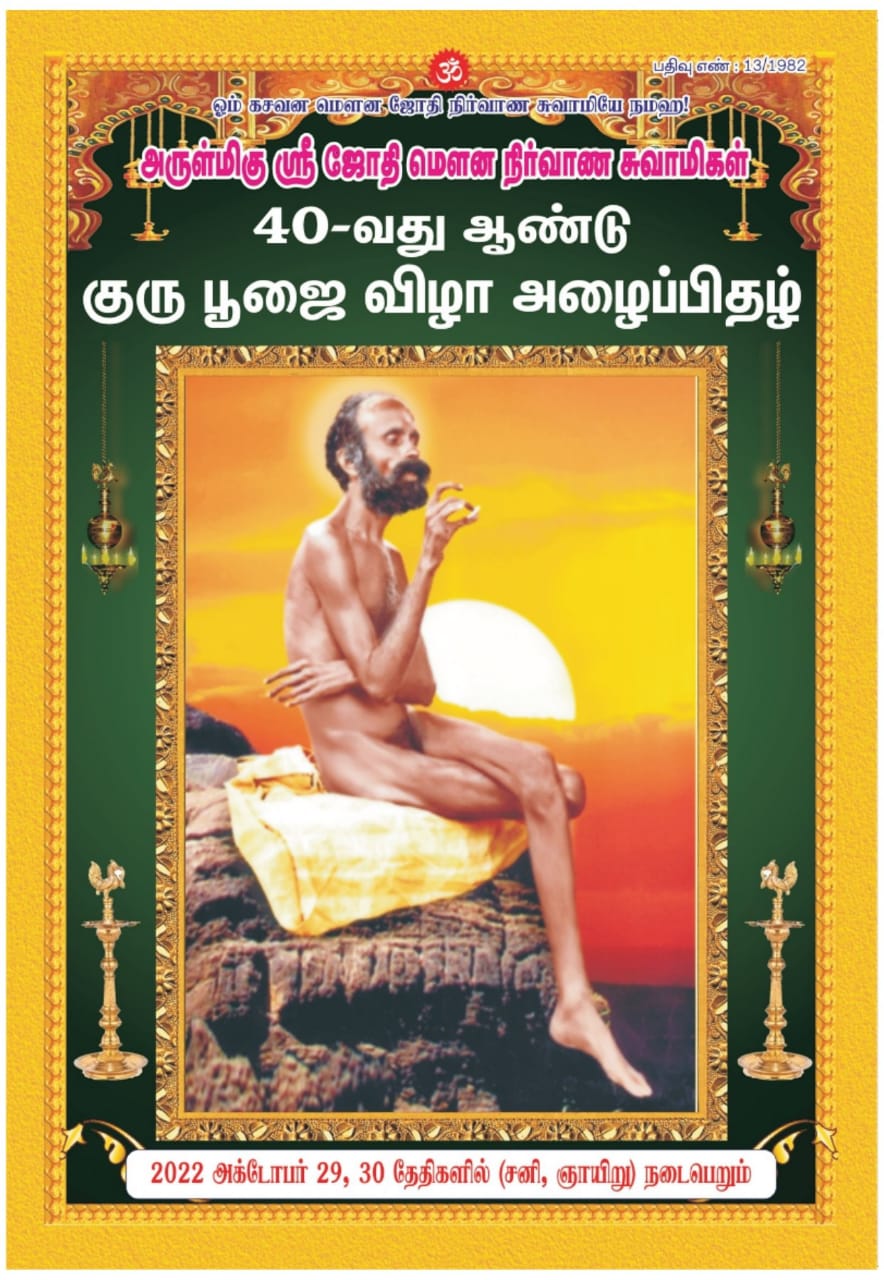

| HOME | HISTORY | SEVAS | POOJA CALENDAR | TESTIMONIALS | CONTACT |
சுவாமியைப் பற்றித் தமிழில் படிக்க இங்கே சொடுக்கவும்
2022 Pooja details- please click here

Exerpts from the book compiled by I.Anandan titled
"The Lord of Kailas at Kasavanampatti"
Here at Kasavanampatti of Dindigul district, Tamilnadu, was an incarnation of the Supreme Brahman, a veritable manifestation of the Absolute in flesh and blood. He lived as Nature made him for about sixty years like a rustic without occupation, and like a lunatic without insanity, sanctifying the soil of the earth by his mere presence and purifying and blessing the whole of humanity by his mere silence. He was an avadhoot (a naked saint) and gnani and a perfect example of Swami Vivekananada's pronouncement: "The highest men are calm, silent and unknown".
Though this sage had no particular name, he was generally known as Sri Jyothi Mouna Nirvana Swami. Though he was mostly silent, people came to him not only from different parts of India but also from some foreign countries to have his darshan and receive his grace and blessings. When devotees visited some reputed saints of Tamilnadu like Yogi Ram Surat Kumar of Thiruvannamalai and Swami Gnanananda Giri of Tirukoilur they would direct their devotees to come to this Brahmavid-Varishtha, saying that he was an Ocean of grace in comparison with whom they were only waves.
Nothing is known about his lineage or parentage. Whence and how he came no one knows. About eighty-five years ago, he was seen on the outskirts of this village as a lad of ten or twelve, completely nude and mute, almost like a lunatic, living on what Mother Earth gave him. Needless to say that such a queer being was an object of ridicule, scorn and harrassment to illetrate rogues and mischievous urchins. But he took umbrage at nothing and ignored their insults with a smile and endured their molestations without a wince. So, in due course, some discerning elders of this hamlet realised that he was not of the common type but a divine personage, and managed to bring him to their village where, after some occasional rambles to other places, he settled for good.
During the early days of his stay the local residents made attempts to dress his person, but to no purpose. No sooner had they put any cloth on him than he would tear it off. So they gave up their vain attempts to clothe him any more and reconciled themselves to his nudity.
At night he would usually rest in a shrine of a goddess situated on the western side of the village. In day time he would sometimes sit on the steps of the temple and occassionally move about the village. He would enter any house and even go to the kitchen and stay there for hours. No one would object to his entry but would treat him as one of their kith and kin.
The Swami would eat very little. He would seldom touch rich and highly flavoured food, but would take simple rice with greens, He would drink tea and milk like medicine, that is to say, not in sips, but in gulps. This shows that he had completely conquered the sense of taste. But he would smake a lot of cigarettes daily. One could observe that even when he refused food and drink he would never decline to smoke any number of cigarettes. According to physicians smoking is highly injurious to health. Then why should such a sage, who had wholely subdued the cravings of the palate, have been an addict to smoking? Evidently it was vicarious atonement. By smoking the cigarettes offered to him by others he took upon himself their ailments and sins.
His speech was of silence; his was the power of silence. Silently he lived, silently he taught and silently he shook of his mortal sheath. He did not lecture, give medicines or uttered any mantras. He would rarely look at the visitors. But his silence worked wonders on all those who came to him, worshipped him or simply remained in his presence went back with peace and prosperity in their lives.
The swami attained Mahasamadhi at the early hours of 22nd October, 1982. Even after his samadhi, a divine light and peace lit up his face for a long while. When his sacred remains were being entombed with due Vedic rites, the sky, which had been clear the whole day, suddenly became overcast and solemnised and sactified the occasion with heavy downpour just over the spot and the red kite (considered as Lord Vishnu's vahanam or carrier) circled three times over the sacred place.
